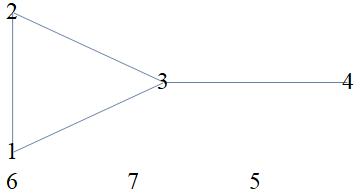I currently plotted a graph with the following code:
AdjacencyGraph[repindhallo2000c,
VertexLabels -> Table[i -> Placed[labels[[i]], Center], {i, 1, 56}],
VertexSize -> Table[j -> figures[[j]], {j, 1, 56}], ImageSize -> 600,
EdgeStyle -> {Arrowheads[0.02]}]
It looks as follows:
Now I have two questions which I could not solve so far:
How is it possible to separate the nodes that they not overlap? As I use different sizes, I would like to show that the larger ones have more directed edges. Therefore I need them not to overlap.
As you can see on the bottom of the graph, apparently there are rows in
repindhallo2000cwhich sum to zero. Hence there are vertices without any connection. Does anyone know how to delete them? Either directly out the adjacency graph or beforehand in the binary matrix.
Here is a small example:
list = List[{1, 0, 1, 0, 1, 1, 1, 1, 0, 1, 1, 0, 1, 0, 1, 1}, {1, 0,
1, 0, 1, 1, 0, 1, 0, 1, 1, 0, 1, 0, 1, 1}, {1, 0, 1, 0, 1, 1, 0,
1, 0, 1, 1, 1, 1, 0, 1, 1}, {1, 1, 1, 0, 1, 1, 0, 1, 0, 1, 1, 1,
1, 0, 1, 1}, {1, 0, 1, 0, 1, 1, 0, 1, 0, 1, 1, 0, 1, 0, 1, 1}, {1,
0, 1, 0, 1, 1, 0, 1, 0, 1, 1, 1, 1, 0, 1, 1}, {1, 1, 1, 0, 1, 1,
0, 1, 0, 1, 1, 0, 1, 0, 1, 1}, {1, 0, 1, 0, 1, 1, 0, 1, 1, 1, 1,
0, 1, 0, 1, 1}, {1, 0, 1, 0, 1, 1, 0, 1, 0, 1, 1, 1, 1, 0, 1,
1}, {1, 0, 1, 0, 1, 1, 0, 1, 0, 1, 1, 1, 1, 0, 1, 1}, {1, 0, 1, 0,
1, 1, 0, 1, 1, 1, 1, 0, 1, 0, 1, 1}, {1, 0, 1, 0, 1, 1, 0, 1, 0,
1, 1, 1, 1, 0, 1, 1}, {1, 1, 1, 0, 1, 1, 0, 1, 0, 1, 1, 1, 1, 0,
1, 1}, {1, 0, 1, 0, 1, 1, 0, 1, 1, 1, 1, 0, 1, 0, 1, 1}, {1, 0, 1,
1, 1, 1, 0, 1, 0, 1, 1, 0, 1, 0, 1, 1}, {1, 0, 1, 0, 1, 1, 0, 1,
1, 1, 1, 1, 1, 0, 1, 1}];
head = List[{"a"}, {"b"}, {"c"}, {"d"}, {"e"}, {"f"}, {"g"}, {"h"}, \
{"i"}, {"j"}, {"k"}, {"l"}, {"m"}, {"n"}, {"o"}];
vertexsize = N[(Total[list]/Total[Total[list]])*15];
AdjacencyGraph[list,
VertexLabels -> Table[i -> Placed[head[[i]], Center], {i, 1, 15}],
VertexSize -> Table[j -> vertexsize[[j]], {j, 1, 15}]]




